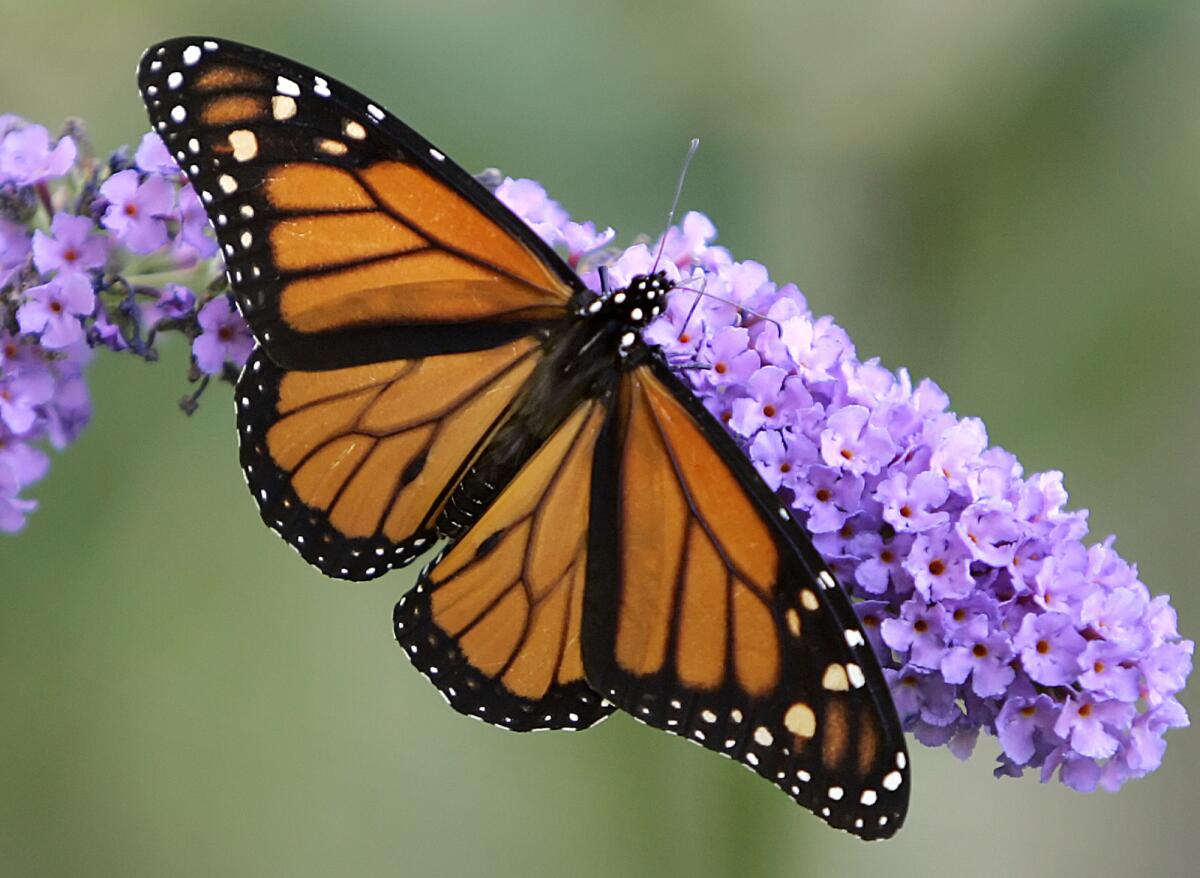Genes reveal answers to monarch butterfly migration mystery

- Share via
A variation in a single gene may explain why some monarch butterfly populations developed a marathoner’s efficient physique, while some muscled up and settled down, according to a new study.
A genome analysis of 101 monarchs from around the globe also suggests that the granddaddy of Danaus plexxipus may not have come from tropical latitudes, but arose in the U.S. Southwest or northern Mexico.
The results, published online Wednesday in the journal Nature, appear to upend long-held assumptions about the monarch, including how it generates a color pattern evocative of a stained-glass sunrise.
“The reason we did so many different analyses in our paper was because some of the coauthors of the paper took so much convincing,” said Marcus Kronforst, an evolutionary biologist at the University of Chicago.
Most butterflies in the genus Danaus are tropical and nonmigratory, including monarchs in Central and South America. That led scientists to assume that populations from more temperate climates, which flit southward then northward by the millions every year, were relatively new branches of the evolutionary tree.
The study flipped both assumptions -- the monarch ancestor likely came from what is now the southwestern U.S. and northern Mexico, and was migratory. In fact, three times in the history of the species migration has been dropped like a bad habit. All three times the change was centered on a gene linked with body and wing structure, according to the study.
“All three of those populations that lost migration have changed in exactly the same way,” said Kronforst. “And that is this collagen gene.”
Collagen is a structural protein for many kinds of connective tissue, including the flight muscle tissue of butterflies. It “made sense,” Kronforst said, that migratory butterflies would differ sharply in the activity of this gene.
“They have to be big and tough and powerful,” Kronforst said. “Then we did the experiments. And it turns out the migratory butterflies have less” of this gene activity. “I thought: This doesn’t make any sense,” Kronforst said. “They should be doing more, not less.”
Still skeptical of the results, researchers forced migratory and nonmigratory monarchs to fly for 20 minutes in a box, where their oxygen use could be measured.
“The nonmigratory butterflies were just burning through oxygen, and the migratory butterflies were super-efficient,” Kronforst said.
Kronforst suspects this example of divergent selection came about because more efficient flight benefited migrating butterflies, while outsprinting competitors for flowers and mates helped the nonmigrating butterflies.
The study estimates that monarchs arose about 2 million years ago. Migratory populations spread to Central and South America about 20,000 years ago, and crossed the Pacific and Atlantic oceans -- perhaps held aloft by massive storms -- about 2,000 years ago, according to the study. That ancient spread across the Pacific may stir controversy, because shipping logs suggest that monarchs began appearing on Pacific islands in the 1800s.
The results raise other questions. While an individual North American monarch makes a trip that can stretch from southern Canada to north-central Mexico, it takes several generations of offspring to “recolonize” the north. Researchers now wonder if this generational difference is regulated by the same gene that appears to separate entire populations of migrating and nonmigrating monarchs.
Another intriguing clue revealed by the study involves the signature coloration that has come to serve as an “orange flag” of toxicity to ward off predators.
It’s well known that Hawaii harbors an ashy white monarch, called nivosus. Most researchers assumed the recessive trait that determined its appearance involved disruption of pigment production. When researchers sequenced the nivosus genome, however, they found the washout came from a traffic jam of sorts. A gene that transports pigment to the wings appears to be different, according to the study.
The butterfly’s myosin gene is roughly equivalent to a gene that affects melanin transport to mouse hair and leaves some of the rodents with a washed-out gray coat. Scientists had previously seen no evidence of any crossover between invertebrates and vertebrates when it comes to color systems, according to Kronforst.
Butterfly researchers also join a long list of people puzzling over Florida. The monarch population there is different from migratory and nonmigratory ones, the study found. It could be a stepping-stone population, but no one is quite sure.
It seems that butterflies, like modern humans, flocked to the Sunshine State and “just decided never to leave,” Kronforst said.







